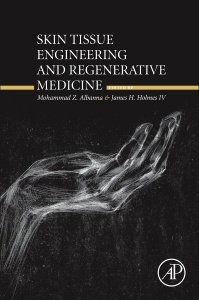Description
Skin Tissue Engineering and Regenerative Medicine
Authors: Albanna Mohammad, Holmes IV James H
Language: English
Subject for Skin Tissue Engineering and Regenerative Medicine:
Keywords
Acellular dermal matrix; Acute wounds; Adipose-derived stem cells; Adult stem cells; Allograft; Alternative test systems; Amniotic stem cells; Animal models; Artificial skin; Autograft; Basement membrane; Bilayer dermal matrix; Bioengineering; Biomaterials; Biopolymer scaffolds; Bioprinter; Bioprinting; Bone marrow-derived stem cells; Burn; Burns; Cathelicidin; Cell culture; Cellular printing; Chronic wound; Chronic wounds; Collagen; Collagen-glycosaminoglycan; Commercialization; Composite cultured skin; Contracture; Cultured fibroblasts; Cultured keratinocytes; Cultured melanocytes; Cytokines; Decellularization; Dermal regeneration template; Dermal tissue generation; Dermis; Design; Diabetic foot ulcer; Disease; Drug development; Embedding; Engineered skin substitutes; Epidemiology; Epidermis; Excision; Extracellular matrix scaffolds; Extracellular matrix; Fabrication; Factors affecting healing; Fibroblasts; Fibroproliferative disease; Fibrosis; Fixation; Gene editing; Growth factors; Histology; Host defense peptide; Hybrid biomaterials; Hypertrophic scar; Hypertrophic; Hypodermis; Innovation; Keloid; Keratinocyte; Keratinocytes; LL-37; Melanocyte; Melanocytes; Mesenchymal stem cells; Microscopy; Natural biomaterial; NIKS; Non-healing wounds; Organotypic skin models; Patient work-up; Perinatal stem cells; Pharmacodynamics; Pharmacokinetics; Presentation; Reconstructive surgery; Regeneration; Regenerative medicine; Regulatory agencies; Resuscitation; Scaffolds; Scar free; Scar reduction; Scar; Scarless wound healing; Scarless; Skin stem cells; Skin substitute; Skin substitutes; Skin tissue engineering; Skin; Stains; Stem cells; Strategic development; Synthetic biomaterials; TGF-�Tissue-engineered skin; Tissue engineering; Tissue processing; Translational research; Vasculature; Wound contraction; Wound healing; Wound regeneration; Xenograft
146.54 €
In Print (Delivery period: 14 days).
Add to cart466 p. · 15x22.8 cm · Paperback
Description
/li>Contents
/li>Readership
/li>Biography
/li>Comment
/li>
The skin is the largest human organ system. Loss of skin integrity due to injury or illness results in a substantial physiologic imbalance and ultimately in severe disability or death. From burn victims to surgical scars and plastic surgery, the therapies resulting from skin tissue engineering and regenerative medicine are important to a broad spectrum of patients.
Skin Tissue Engineering and Regenerative Medicine provides a translational link for biomedical researchers across fields to understand the inter-disciplinary approaches which expanded available therapies for patients and additional research collaboration. This work expands on the primary literature on the state of the art of cell therapies and biomaterials to review the most widely used surgical therapies for the specific clinical scenarios.
biomedical researchers in the fields of tissue engineering and regenerative medicine; stem cell researchers
Dr. Holmes is an Associate Professor of Surgery and the Director of Wake Forest Baptist Medical Center (WFBMC) Burn Center. He is the current Chair of the American Burn Association (ABA) Southern Region. He is acting as the leading principal investigator for multiple burn clinical trials and is the current Chair of the ABA Multicenter Trials Group Burn Science Advisory Panel. He is co-author of an ABA white paper on the medical practice of treatment of wounds. He is author of many peer-reviewed journal papers and book chapters in the field of burns and wound healing.
- Explores cellular and molecular processes of wound healing, scar formation, and dermal repair
- Includes examples of animal models for wound healing and translation to the clinical world
- Presents the current state of, and clinical opportunities for, extracellular matrices, natural biomaterials, synthetic biomaterials, biologic skin substitutes, and adult and fetal stem and skin cells for skin regenerative therapies and wound management
- Discusses new innovative approaches for wound healing including skin bioprinting and directed cellular therapies

